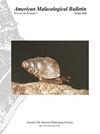Thermal Tolerance Limits of the Chinese Mystery Snail (Bellamya chinensis): Implications for Management
IF 0.4
4区 生物学
Q4 MARINE & FRESHWATER BIOLOGY
引用次数: 5
Abstract
Abstract: The Chinese mystery snail, Bellamya chinensis (Gray, 1834) is a gastropod native to East Asia and is considered an invasive species in North America where its impacts on native species and ecosystems are not well understood. Scientific literature describing its biology and life history are sparse. Thermal tolerance limits, or the maximum and minimum temperature under which a species can survive, are key to identifying the potential geographical range of a species. The ability of managers to control invasive species is directly impacted by the thermal tolerance limits of a species. We attempted to identify the thermal tolerance limits of B. chinensis in a laboratory setting. Using a random sampling design, we exposed groups of wild-caught B. chinensis to either extreme high or low temperature treatments. We identified the upper temperature tolerance limit as between 40 and 45 °C. This result indicates some hot water management techniques may successfully prevent spread of B. chinensis among waterways. Despite exposing B. chinensis to freezing temperatures for extended periods of time we did not identify a lower temperature limit. Identifying the thermal tolerance limits of this and other invasive species informs predictions of range expansion and identification of potential prevention efforts.中华神秘蜗牛(Bellamya chinensis)的耐热极限及其管理意义
摘要:中国神秘蜗牛Bellamya chinensis(Gray,1834)是一种原产于东亚的腹足类动物,在北美被认为是一种入侵物种,其对本地物种和生态系统的影响尚不清楚。描述其生物学和生命史的科学文献很少。耐热极限,或一个物种能够生存的最高和最低温度,是确定一个物种潜在地理范围的关键。管理者控制入侵物种的能力直接受到物种耐热极限的影响。我们试图在实验室环境中确定B.chinensis的耐热极限。采用随机抽样设计,我们将野生捕获的中华鳖群暴露在极端高温或低温处理下。我们确定温度公差上限在40到45°C之间。这一结果表明,一些热水管理技术可以成功地防止中华鳖在水道中的传播。尽管将B.chinensis暴露在冰冻温度下很长一段时间,但我们没有确定较低的温度限制。确定这种入侵物种和其他入侵物种的耐热极限,可以预测范围的扩大和确定潜在的预防措施。
本文章由计算机程序翻译,如有差异,请以英文原文为准。
求助全文
约1分钟内获得全文
求助全文
来源期刊
CiteScore
1.00
自引率
40.00%
发文量
1
审稿时长
>12 weeks
期刊介绍:
The American Malacological Bulletin serves as an outlet for reporting notable contributions in malacological research. Manuscripts concerning any aspect of original, unpublished research,important short reports, and detailed reviews dealing with molluscs will be considered for publication. Recent issues have included AMS symposia, independent papers, research notes,and book reviews. All published research articles in this journal have undergone rigorous peer review, based on initial editor screening and anonymous reviewing by independent expertreferees. AMS symposium papers have undergone peer review by symposium organizer, symposium participants, and independent referees.

 求助内容:
求助内容: 应助结果提醒方式:
应助结果提醒方式:


